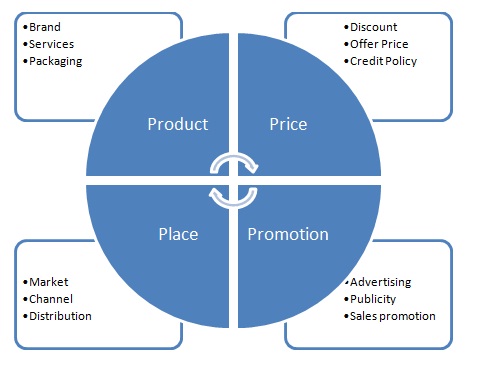4 p marketing
When it comes to creating an effective marketing strategy, understanding the 4 P’s of Marketing is crucial. These four elements, also known as the marketing mix, are Product, Price, Place, and Promotion. Each plays a vital role in shaping a successful marketing campaign.
What are the 4 P’s of Marketing?
- Product: This refers to the tangible or intangible item that your business offers to customers. It encompasses the features, design, packaging, and branding of the product.
- Price: Determining the right price for your product is essential. It involves understanding your target market, competitors, and the perceived value of your product to customers.
- Place: Place refers to the distribution channels through which your product reaches customers. It involves making decisions about retail locations, online platforms, and supply chain management.
- Promotion: Promotion is all about creating awareness and generating interest in your product. This can be done through various marketing tactics such as advertising, public relations, social media campaigns, and sales promotions.
Benefits of implementing the 4 P’s in your marketing strategy
By incorporating the 4 P’s of Marketing into your strategy, you can achieve several benefits:
- Targeted Marketing: The 4 P’s help you understand your target market and tailor your marketing efforts accordingly, improving the effectiveness of your promotions.
- Increased Sales: When you have a well-defined product, price, place, and promotion strategy, you are more likely to attract customers and drive sales.
- Competitive Advantage: By carefully crafting each element of the marketing mix, you can differentiate your business and stand out from competitors.
- Customer Satisfaction: A well-thought-out marketing mix ensures that your product meets customer needs, enhances their experience, and builds loyalty.
Understanding and implementing the 4 P’s of Marketing can give your business a strong foundation for successful marketing campaigns.
:max_bytes(150000):strip_icc()/Term-Definitions_Marketing-mix-53d91eacb6d74329ba0d2fffe7800a6d.jpg)
Product
Definition and importance of the product in marketing
The product is a crucial component of the marketing mix. It refers to the goods or services offered by a company to meet customer needs and wants. In marketing, the product plays a vital role in creating value and satisfying customer demands. It is essential to understand the target market, consumer preferences, and competitor offerings to develop a successful product strategy.
Product development and innovation
Product development and innovation are key factors in achieving long-term success. Companies must continuously evolve and introduce new products or enhance existing ones to stay competitive. This involves conducting market research, identifying customer needs, and using creativity and technology to develop innovative solutions. By staying ahead of the curve and adapting to changing trends, businesses can maintain a loyal customer base and attract new customers.
Product pricing and positioning strategies
Pricing and positioning are critical elements in marketing a product effectively. Pricing strategies involve determining the right price to maximize profits while considering factors such as production costs, competition, and customer perceptions of value. Positioning strategies focus on how the product is perceived in the market relative to competitors. This includes establishing a unique selling proposition, targeting specific market segments, and differentiating the product from others.
In conclusion, the product is a fundamental aspect of marketing, and its development, innovation, pricing, and positioning strategies are essential for a company’s success. By understanding customer needs, staying innovative, and effectively positioning the product in the market, businesses can gain a competitive edge and achieve their marketing goals.

Price
When it comes to marketing, pricing is a crucial element that can greatly impact the success of your business. Understanding the concept of pricing and its factors is essential for making informed decisions and implementing effective strategies.
Understanding the concept of pricing in marketing
Price is more than just a number on a product or service. It represents the value that customers perceive and are willing to pay. It is influenced by various factors, including production costs, competition, market demand, and customer perception.
Factors influencing pricing decisions
Several factors play a role in determining the right price for your product or service. These include understanding customer needs and preferences, analyzing competitors’ pricing strategies, considering production and distribution costs, and evaluating market conditions and trends.
Pricing strategies and tactics for different markets
Different markets require different pricing strategies to effectively capture customer attention and maximize profitability. Some common strategies include cost-based pricing, value-based pricing, skimming pricing, penetration pricing, and psychological pricing. It is important to assess your target market, competition, and the unique value your product or service offers before deciding on the most suitable pricing approach.
Remember, pricing is not a one-time decision. It requires continuous evaluation and adjustment to adapt to market changes and meet customer expectations. By understanding the concept of pricing, considering influencing factors, and implementing appropriate strategies, you can optimize your pricing and drive the success of your marketing efforts.

Promotion
Importance of promotion in marketing
Promotion plays a crucial role in marketing by creating awareness and driving sales for businesses. By promoting their products or services, companies can effectively communicate their value proposition to the target audience. Promotional efforts help generate interest, create desire, and ultimately lead to action from potential customers. It is through promotion that businesses can differentiate themselves from competitors and establish a strong brand presence in the market.
Different promotional activities and channels
There are various promotional activities and channels that businesses can utilize to reach their target audience. These include advertising through traditional media such as television, radio, and print, as well as online platforms like social media, search engine marketing, and email marketing. Other promotional activities include sales promotions, public relations, direct marketing, and event marketing. The choice of promotional activities and channels depends on the target market, budget, and marketing objectives of the business.
Creating effective promotional campaigns
To create effective promotional campaigns, businesses need to carefully plan and execute their strategies. This involves identifying the target audience, determining the key messages, selecting the most appropriate promotional channels, and measuring the success of the campaign. It is essential to craft compelling and persuasive content that resonates with the target audience and motivates them to take action. By monitoring and analyzing the results of the promotional campaigns, businesses can make data-driven decisions and continuously improve their marketing efforts.
Remember, effective promotion is not just about generating immediate sales but also building long-term customer relationships and brand loyalty. By consistently delivering value and engaging with customers through promotional activities, businesses can strengthen their market presence and achieve sustainable growth.

Place
Role of place in marketing
In the world of marketing, “place” refers to the distribution channels and physical locations where products or services are made available to customers. It plays a crucial role in the overall marketing strategy of a business.
Distribution channels and strategies
Effective distribution channels and strategies ensure that products reach the right customers at the right time and in the most convenient way. This includes considering factors such as direct sales, retail outlets, online platforms, wholesalers, and intermediaries. By carefully selecting and managing distribution channels, businesses can effectively deliver their products and communicate their brand message to their target market.
Location and accessibility considerations
When deciding on a physical location for a business, several factors should be taken into consideration. This includes accessibility to customers, proximity to suppliers or manufacturers, transportation infrastructure, and local business regulations. Understanding the target market and their preferences can help determine the ideal location and accessibility of a business.
By strategically choosing the right place, businesses can improve customer convenience, increase market reach, and enhance overall brand perception. It is important to continuously evaluate and adapt distribution channels and location strategies to stay competitive and meet customer demands.

In conclusion, the 4 P’s of marketing – product, price, place, and promotion – are essential elements for the success of any business. By considering these factors, businesses can effectively plan and execute their marketing strategies to meet the needs and desires of their target audience. The benefits of incorporating the 4 P’s include creating a unique value proposition, optimizing pricing strategies, reaching and engaging the right customers through appropriate channels, and effectively promoting products and services. Many successful businesses, such as Apple, Coca-Cola, and Nike, have implemented the 4 P’s to achieve their marketing goals. Frequently asked questions about the 4 P’s of marketing may include inquiries about how to determine the right pricing strategy, how to select the optimal distribution channels, and how to create effective promotional campaigns. By understanding and implementing the 4 P’s, businesses can enhance their marketing efforts and achieve long-term success.
The 4Ps of marketing are a framework that businesses can use to develop and implement their marketing strategies. The 4Ps are:
- Product: The product or service that the business is offering.
- Price: The price that the business is charging for its product or service.
- Place: The channels through which the business makes its product or service available to customers.
- Promotion: The methods that the business uses to communicate with potential and existing customers about its product or service.
The 4Ps of marketing can be used to develop a holistic approach to marketing that takes into account all of the factors that influence customer decision-making. By carefully considering each of the 4Ps, businesses can develop marketing strategies that are more likely to be successful.
Here are some examples of how businesses can use the 4Ps of marketing:
- Product: A restaurant might use the 4Ps of marketing to develop a new menu item, such as a new type of burger. The restaurant would consider the burger’s features, benefits, and price, as well as how it would be marketed and distributed.
- Price: A clothing retailer might use the 4Ps of marketing to decide on the price of a new line of jeans. The retailer would consider the cost of manufacturing the jeans, the competition, and the target customer’s budget.
- Place: A software company might use the 4Ps of marketing to decide how to distribute its new software product. The company would consider online distribution channels, such as its own website and app stores, as well as offline distribution channels, such as physical retailers.
- Promotion: A travel agency might use the 4Ps of marketing to develop a new marketing campaign for a vacation package to Mexico. The agency would consider the target audience, the message of the campaign, and the media channels that would be used to reach the target audience.
By carefully considering each of the 4Ps of marketing, businesses can develop strategies that are more likely to be successful in meeting the needs of their target customers.
Smart marketing can be used to improve the effectiveness of the 4Ps of marketing. For example, a smart marketer might use data to segment their target audience and develop targeted marketing campaigns for each segment. A smart marketer might also use data to track the results of their marketing campaigns and use this data to improve their future campaigns.
By using smart marketing techniques, businesses can improve their marketing campaigns and achieve their business goals more effectively.
